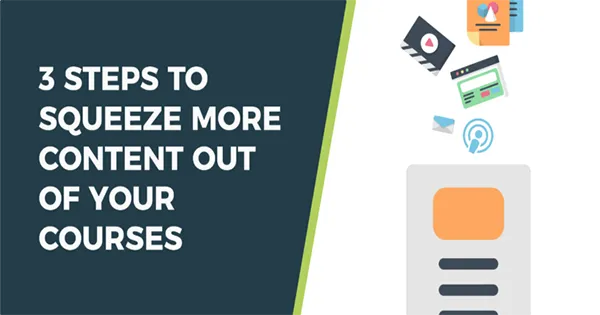Kyvio Blog

3 Steps to Squeeze More Content Out of Your Courses
Let’s face it… You may come up with several brilliant content ideas that keep your content going. However, day after day, trying to fetch fresh ideas turns out to be more work than you expected.
As business owners, we tend to think that every piece of content we produce must be an original, never-thought-of idea.
While this approach is the most utopic one, there are still ways to create outstanding content with less effort and struggle.
One of those ways is content recycling.
Do you have any existing content that could be transformed or reused? That could be video into text, text into a graphic, or podcast into an email series. You are free to choose the formats that work best for you.
Now let’s dive into one kind of transformation that could make a HUGE difference: turning a course into reusable content.
Why Smart Business Owners Choose To Repurpose Courses’ Content
If you’re creating a course, chances are you’ve spent a lot of time and effort in the process.
Your course must bring a lot of value to its audience. So you don’t have to limit it to your students. Transform the information you present in your course into a blog article, and present it to your blog readers.
Recycling content of courses into shorter forms of content is a time saving, guilt-free shortcut to generating new valuable content. It also saves you a lot of time and effort thinking of new content ideas.
This strategy works so well that you will find more students signing up for your course.
Here’s What You’ll Gain From Creating Content From Your Course
Save Time and Effort
Recycling your content helps you save time and effort, while still maintaining the quality of your content. As the knowledge you’re sharing with your students in a course is most likely to turn into high quality written content. So why waste your time looking for new ideas?

Recycling content will allow you to save your focus for other areas in your business.
Boosting Your SEO
As you create more content, you’ll have more indexed pages and more opportunities to get backlinks. Indexed pages that have more backlinks rank higher on Google, as this is a sign that your content has more value.
Boosting Your Credibility
Your course is probably specialized in a niche field; a field you know most about. So turning that into blog articles will make your content the most valuable in your area of expertise. You’ll become a thought leader in your niche. Moreover, sharing relevant and original content will also increase your opportunities of being featured in podcasts and conferences, and getting in touch with people who are more likely to buy your course.
Build Trust With Your Readers
You will be teaching your readers to solve a problem that you have covered in your course. As they see positive results in their lives, they’ll know, value, and trust you and your content. They would by then have gotten a taste of what you’re offering them. So it will make it easier to sell them the course.
All of this sounds great and easy, but you should be careful not to fall in one dreadful trap: giving away everything for free.
When turning your course content to everyday content, you should be careful not to reveal all your secrets. No one will register for your course if it’s given up for free on your blog.
So how do you create more content from your course without giving everything away for free?
3 Easy Steps For Creating More Content From Your Course
Step 1: Pick One Topic In Your Course
Your course teaches people various skills that help them overcome an obstacle in their lives. Identify one concise topic around a one specific pain point that affects your target market and create content around it. This topic should give them quick victories when solving their problems.
Here’s one example of how I did it to one of my courses:
I created a course on ‘How to be an Affiliate and Make Cryptocurrencies.’ This course covers nine different topics.
Cryptocurrency is a hard topic. So I’m limited to people who are already familiar with it and understand affiliate marketing.
But what if I want to target beginners? What if among my audience are people who don’t know what cryptocurrency is.
In that case, it’s crucial to select a section of the course with easy to digest information. As it will give beginners the basics they need, and gradually prepare them to consume the whole course material.
Topic selected: Introduction to Cryptocurrencies.
It covers:
Cryptos and blockchain
Terminologies
Crypto Categories
What the future holds
ICO and Q/A
Step 2: Split The Topic Into Sections That Will Add Up To 30 Days.
I selected ‘Introduction to Cryptocurrency,’ so here’s an example of content ideas for a 30-day email sequence:
Day 1- 6: Cryptocurrencies and Blockchain
Day 7-12: Terminologies
Day 13-18: Crypto Categories
Day 19-24: What the future holds
Day 25-30: ICO and Q/A

You may want to create other content types. It’s entirely up to you. You can generate:
Visuals e.g. Memes and Infographics
Blog Posts e.g. How To Posts and Ultimate Guides
Videos and Podcasts
Also, you can choose to allocate a different number of days to each topic. It will depend on the quantity of content each section entails.
Step 3: Write Down The Problem And Aspiration Related To The Topic You Selected.
This step will guide you as you write; helping you avoid getting stuck and deviating from the core idea of your piece.
Identify the problem: For the topic you have selected, what pain point does it
solve?
Identify the Aspiration: How does it make life better for your target market?
What is life like after the student has studied the topic and finished it?
Here’s an example:
Problem: I don’t know what Cryptocurrencies are
Aspiration: I know what Cryptocurrencies and Blockchains are, and I’m ready to study more topics about them.
To Conclude
Keep your content engaging. Write in-depth blog posts and engaging emails. Create eye-catching visuals and videos. Also once you finish, promote your content to your readers because if people don’t read it, it’s as good as dead.
Learn more about how you can promote your content through social syndication here.
Remember to have a lead capture form with a lead magnet to collect contact information from your readers. It will help you filter out those who are willing to learn more and those who aren’t. Then you can send more content to only those who are interested and, those who have a higher chance of buying your course.
Don’t Create New Ideas- Multiply What You Have
Getting new content ideas will be time-consuming. At the same time, your readers want more of what they are already getting.
That is why splitting the topics in your course content is a smart move for the time-crunched business owner.
Getting started is easy, but building up your library of content ideas requires looking deeper into what your audience wants.
And if you already have solid course content, you have a big head start.
So, why not start splitting a topic to get more content ideas from one course?
Because I can guarantee you one thing – your course has a ton of brilliant ideas, and some of these ideas would make the best content you have ever published to date… if you only knew about them.
All you need is to do is get started.
If you’re reading this, then you must have enjoyed this article. Spread the word, and share this post with your friends, they will thank you.



